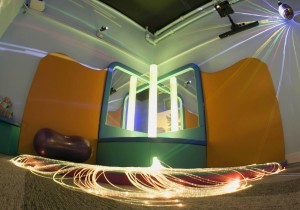Calm, attentive, socially engaged children. What parent or teacher could ask for more than that? But for some of our children with Additional Learning Needs, a more supportive school environment is required to bring out the best in our children. For some, who retreat into their own world of repetitive behaviours, gentle stimulation in a safe space encourages them to communicate. For others, who need to calm down and feel at ease with themselves, a failure free space decreases stress. In both cases, time in a Sensory Room helps the children become more aware and able to regulate their own emotional levels and to develop a mind-set conducive to learning.
THE OFFICIAL LAUNCH
In May of last year, a planning group of staff and parents was set up to create a Sensory Room, and less than a year later the official opening ceremony was held. Of course, many meetings and consultations with experts took place in the intervening 11 months! The room was funded by the board of management, and volunteer parents and staff helped to keep the costs within budget by doing much of the preparatory work and finishing touches. A specialist retailer was contracted to install the multi-sensory products. The room was named the Seomra Sonais (Room of Happiness/Tranquillity) and all the children of the school were invited to actively partake in the official launch by designing a door plaque for the room. See the winning entry chosen by The Students Council below. The opening ceremony was largely conducted by the children, and relayed via video link from the Sensory Room to all the classes watching the proceedings in the school hall. Master of Ceremonies was the chairperson of the Students Council. A representative from each class described their favourite aspect of the room. A regular user of the room, who acted as enthusiastic guide to visitors to the room, presented a Thank You card to the parents involved. Other presentations by children included the door plaque and an original mindfulness poem. The ceremony concluded with the cutting of the ribbon by the oldest and youngest children in the school, accompanied by great cheers and applause from the school hall!
Calm, attentive, socially engaged children. What parent or teacher could ask for more than that?
HOW DOES THE SENSORY ROOM HELP CHILDREN LEARN?
At first glance a Sensory Room looks like a fun playroom or even a dance studio with disco lights! Nothing could be further from the truth! Children with Additional Learning Needs such as Autism can be overwhelmed by everyday sounds and lights. The chattering of their classmates, the rustling of paper and the brightly lit classroom can be overpowering. In a Sensory Room, the child with Autism, for example, can control the environment of the room as best suits him/her. The child who intensely dislikes light may choose to turn off all lights and gently explore soft textures through touch. For another child, observing the stars on the black ceiling encourages eye tracking and attention. After a short period in the Sensory Room the child is ready to learn in the everyday hustle and bustle of a modern busy classroom. For the child with Emotional Disorders, engagement in guided meditations in the Sensory Room is enhanced by the totality of experience. The child may choose to lie on a beanbag, wrapped in a soft blanket, watching and listening to the waves on a beach scene projected onto the wall, resulting in a serene mental state. The child’s interpersonal relationship with the teacher or SNA is enhanced as the staff member becomes more responsive to the child’s needs and this has a positive knock-on effect with other people in the child’s life. The room is also ideal for those children with transient difficulties in their lives, such as those experiencing loss or stress. Children take a break from their worries, and realise they can be happy again, as they engage with the exotic fish in the bubble tube or the twinkling lights in the fibre-optic strings.
WHAT DOES THE SENSORY ROOM LOOK LIKE?
The walls are painted in a soft blue colour to maximise the therapeutic effects of the equipment and the ceiling is painted black to mimic the night sky. What immediately catches the eye is the soft area with a large lighted bubble tube where children and observe with fascination the bubbles and the exotic fish. Moving clouds and twinkling stars move across the black ceiling painted to represent the night sky. A projector presents a beautiful waterfall or beach scene on the walls to transport the children to a beautiful place, accompanied by birdsong or the lapping of waves. The mirror ball casts coloured lights around the room, and music or nature sounds can be played as required. Small wind-up torches and other toys develop hand strength and fine motor coordination, skills that are valuable for learning. Gross motor skills and body awareness are promoted through use of the exercise ball, the beanbags and the mirrors. While the picture below shows many of components of the room in use, in reality certain aspects only will be chosen to personalise the experience.
The room is a suitable space for creative activities with small groups. With the help of the images and sounds projected into the room, children can use their imagination to visualise themselves in another timeframe or place on earth and be inspired to write about their experiences.
A FINAL WORD
We are so grateful to all the children, parents, staff and the other schools and experts we consulted with, for their help, advice, suggestions and cooperation in bringing the idea of a Sensory Room to such a wonderful reality. The opening Ceremony was not just a celebration, it was also a concrete expression of the whole school’s commitment to those children who need the room, and will help them, their peers and parents have a nicer and more productive day. The last word on the Sensory Room should go to a 4th Class child who says, “I really love going to the Seomra Sonais every day. It helps me to be my best self.”
Petrina, Sensory Room Project Co-Ordinator


Recent Comments